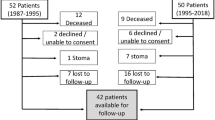Abstract
Introduction
Long-term outcome after surgery for slow transit constipation is conflicting. The aim of this study was to assess long-term quality of life after surgery.
Methods
The medical records of all patients undergoing colectomy with ileorectal anastomosis between 1983 and 1998 were evaluated. Preoperative, operative, and postoperative details were recorded. A survey was conducted to evaluate current symptoms and health. Quality of life was assessed using the short-form (SF)-36 survey.
Results
Sixty-nine (2 male) patients were identified. Five were deceased. Mean age at surgery was 38.6 years (range, 19.7–78.8 years). Median follow-up after surgery was 10.8 years (range, 5.1–18.6 years). Forty-one percent had a family history of constipation. Eleven (16%) had an ileus postoperatively, which responded to medical therapy. One patient had a leak that required temporary diversion. Long-term complications occurred in 32 (46%) patients, which included hernias (3 patients; 4%), pelvic abscess (1 patient; 1.5%), rectal pain (1 patient; 1.5%), small-bowel obstruction (14 patients; 20%, with eight requiring surgery), diarrhea (5 patients; 7%), incontinence (1 patient, 1.5%), and persistent constipation (6 patients; 9%). Fifty-five percent (35/64) responded to a questionnaire. Overall, 25 of 35 (77% of the respondents) stated that surgery was beneficial. Sixty-four percent of patients have semisolid stools, 35% have liquid stools, and 4% reported hard stool. Results of the SF-36 showed the physical component score was comparable with healthy individuals. However, the mental component score was low especially in the areas of vitality (median, 45) and social functioning (median, 37).
Conclusion
Surgery for constipation is not perfect, and preoperative symptoms may persist after surgery. When assessing long-term quality of life, the mental component of the SF-36 was low compared with the general population, and the physical component was similar. Moreover, because 77% report long-term improvement, surgery is beneficial for appropriate patients.
Similar content being viewed by others
References
Sonnenberg A, Koch TR (1989) Physician visits in the United States for constipation: 1958 to 1986. Dig Dis Sci 34(4):606–611
Johanson JF, Sonnenberg A, TR K (1989) Clinical epidemiology of chronic constipation. J Clin Gastroenterol 11(5):525–536
Levitt MA, Peña A (2005) Surgery and constipation: when, how, yes, or no? Pediatr Gastroenterol Nutr 41(Suppl 1):S58–S60
Kamm MA, Hawley PR, Lennard-Jones JE (1988) Outcome of colectomy for severe idiopathic constipation. Gut 29(7):969–973
Christiansen J, OO R (1996) Colectomy for severe slow-transit constipation in strictly selected patients. Scand J Gastroenterol 31(8):770–773
Nyam DC, Pemberton JH, Ilstrup DM, Rath DM (1997) Long-term results of surgery for chronic constipation. Dis Colon Rectum 40(3):273–279
Nylund G, Oresland T, Fasth S, Nordgren S (2001) Long-term outcome after colectomy in severe idiopathic constipation. Colorectal Dis 3(4):253–258
Webster C, Dayton M (2001) Results for colectomy for colonic inertia: a sixteen year experience. Am J Surg 182:639–644
Beck DE, Fazio VW, Jagleman DG, Lavery IC (1989) Surgical management of colonic inertia. South Med J 82:305–309
Sample C, Gupta R, Bambriz F, Anvari M (2004) Laparoscopic subtotal colectomy for colonic inertia. J Gastrointest Surg 9(6):803–808
Kessler H, Hohenberger W (2005) Laparoscopic total colectomy for slow-transit constipation. Dis Colon Rectum 48(4):860–861
Sarli L, Costi R, Iusco D, Roncoroni L (2003) Long-term results of subtotal colectomy with antiperistaltic cecoproctostomy. Surg Today 33(11):823–827
Lees NP, Hodson P, Hill J et al (2004) Long-term results of the antegrade continent enema procedure for constipation in adults. Colorectal Dis 6(5):362–368
Hill J, Scott S, MacLennan I et al (1994) Antegrade enemas for the treatment of severe idiopathic constipation. Br J Surg 81:1490–1491
Gerharz EW, Vik V, Webb G, Leaver R et al (1997) The value of the MACE (Malone antegrade colonic enema. J Am Coll Surg 185(6):544–754
Scarpa M, Barollo M, Keighley MR (2005) Ileostomy for constipation: long-term postoperative outcome. Colorectal Dis 7(3):224–227
Malouf AJ, Wiesel PH, Nicholls T et al (2001) Short term effects of sacral nerve stimulation for idiopathic slow transit constipation. World J Surg 26:166–170
Kenefick NJ, Nicholls RJ, Cohen RG, Kamm MA (2002) Permanent sacral nerve stimulation for treatment of idiopathic constipation. Br J Surg 89(7):882–888
Mollen RM, Kuijpers HC, Claassen AT (2001) Colectomy for slow-transit constipation: preoperative functional evaluation is important but not a guarantee for a successful outcome. Dis Colon Rectum 44(4):577–580
Rantis PC Jr, Vernava AM III, Daniel GL, Longo WE (1997) Chronic constipation—is the work-up worth the cost? Dis Colon Rectum 40(3):280–286
Glia A, Akerlund JE, Lindberg G (2004) Outcome of colectomy for slow-transit constipation in relation to presence of small-bowel dysmotility. Dis Colon Rectum 47(1):96–102
Pluta H, Bowes KL, Jewell LD (1996) Long-term results of total abdominal colectomy for chronic idiopathic constipation. Value of preoperative assessment. Dis Colon Rectum 39(2):160–166
Piccirillo MF, Reissman P, Wexner SD (1995) Colectomy as treatment for constipation in selected patients. Br J Surg 82(7):898–901
Drossman DA (1999) The functional disorders and the Rome 2 process. Gut 45:111–115
Ghosh S, Papachrysostomou M, Batool M, Eastwood MA (1996) Long-term results of subtotal colectomy and evidence of noncolonic involvement in patients with idiopathic slow-transit constipation. Scand J Gastroenterol 31(11):1083–1091
Author information
Authors and Affiliations
Corresponding author
Rights and permissions
About this article
Cite this article
Zutshi, M., Hull, T.L., Trzcinski, R. et al. Surgery for slow transit constipation: are we helping patients?. Int J Colorectal Dis 22, 265–269 (2007). https://doi.org/10.1007/s00384-006-0189-3
Received:
Published:
Issue Date:
DOI: https://doi.org/10.1007/s00384-006-0189-3




